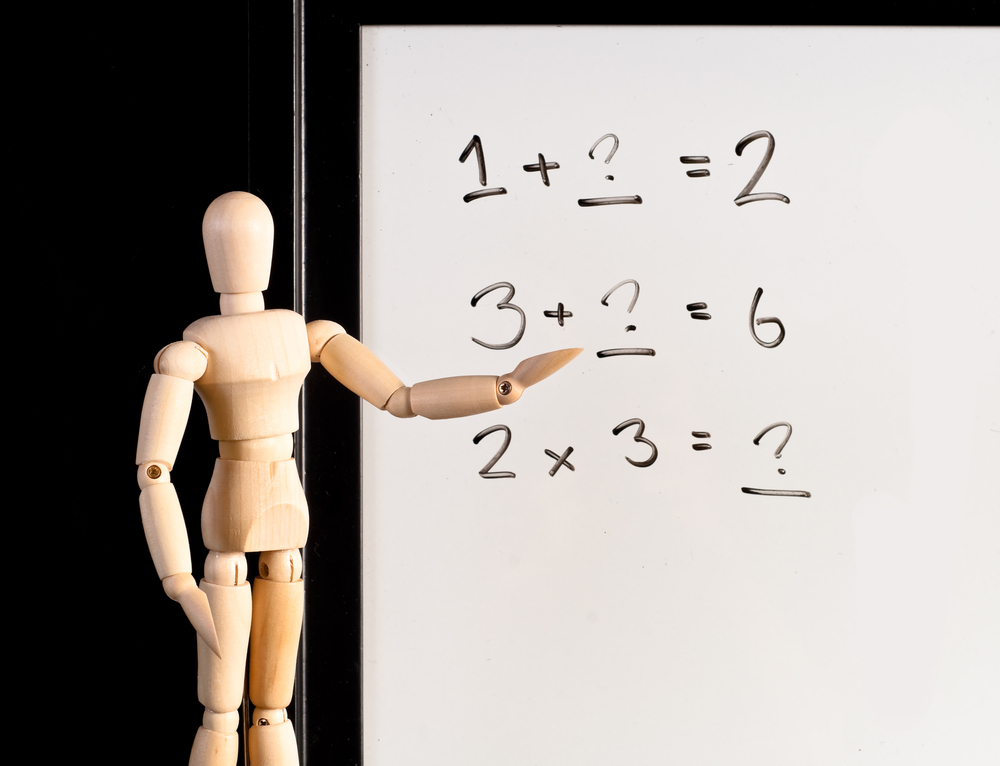|
 Equations in mathematics are like sentences in English. All equations contain an equals sign, "=". Equations have variables, such as x or p to stand for "unknown" quantities. Equations in mathematics are like sentences in English. All equations contain an equals sign, "=". Equations have variables, such as x or p to stand for "unknown" quantities.
The value of these varaibles can often be found by guessing, or using more mathematical methods.
|
"I think of a number and add 3 to it."
"The result is 8. "
"What is the number?"
|

|
Most people can easily work out that the number is 5.
In mathematics, we would write an equation x + 3 = 8, where x stands for the number. We would then solve the equation to find the value of the number (x). This sounds a long way of doing things but many equations are more difficult to solve than the one above.
Some equations have more than one answer:
|
x2 = 9
|
x could be 3 or -3
|
Some equations have more than one variable:
|
x + y = 9
|
There are lots of possible answers.
e.g. x could be 3 and y could be 6
or
x could be 4 and y could be 5.
|
There are several types of equations and several methods of solving them. These are studied in more detail in later years.
Simple Equations
- These equations are sometimes called linear equations.
- These equations usually have one variable, like the problem above and only one answer.
- Equations can sometimes be solved by working out the answer in your head. (Guess and check.) This method usually works for simple equations only.
- The aim when solving an equation is find the value of the variable that makes the equation true.
- Always check that the answer is correct by substituting your answer back into the equation.
| Examples |
Method One (Guess and check) |
Method Two (balancing both sides)
|
|
x + 7 = 15
|
Guess:
What is added to 7 to give 15?
The answer must be x = 8.
|
x + 7 = 15
x + 7 − 7 = 15 − 7 (subtract 7 from both sides)
x = 8
|
|
Check:
Left hand side = 8 + 7 = 15
Right hand side = 15
Therefore the answer is correct.
|
|
g − 5 = 11
|
Guess:
What number would you subtract 5 from to give 11?
The answer must be g = 16.
|
g − 5 = 11
g − 5 + 5 = 11 + 5 (add 5 to both sides)
g = 16
|
|
Check:
Left hand side = 16 − 5 = 11
Right hand side = 11
Therefore the answer is correct.
|
| 3w = 15
|
Guess:
What number would you multiply 3 by to give 15?
The answer must be w = 5. |
3w = 15
3w⁄3 = 15⁄3 (divide both sides by 3)
w = 5
|
|
Check:
Left hand side = 3 x 5 = 15
Right hand side = 15
Therefore the answer is correct.
|
| p ÷ 8 = 4 |
Guess:
What number would you divide by 8 to give 4?
The answer must be w = 32. |
p ÷ 8 = 4
p ÷ 8 x 8 = 4 x 8 (multiply both sides by 8)
p = 32
|
|
Check:
Left hand side = 32 ÷ 8 = 4
Right hand side = 4
Therefore the answer is correct.
|
| 2p + 5 = 17 |
Guess:
What number would you multiply by 2 and add 5 to give 17?
The answer must be w = 6. |
2p + 5 = 17
2p + 5 − 5 = 17 − 5 (subtract 5 from both sides)
2p = 12
2p ÷ 2 = 12 ÷ 2 (divide both sides by 2)
p = 6
|
|
Check:
Left hand side = 2 × 6 + 5 = 17
Right hand side = 17
Therefore the answer is correct.
|
Word Problems
Many word problems can be solved by making equations and solving them.
The general way to approach these problems is:
- Let a variable or letter be the unknown quantity in the problem.
- Make up an equation from the information in the problem.
- Solve the equation.
| Example |
Answer |
|
Charlotte thinks of a number, doubles it and adds 6.
The result is 26.
What is her number?
|
Let the unknown number be x.
The equation is:
2x + 6 = 26
Solving the equation:
2x + 6 − 6 = 26 − 6
2x = 20
x = 10
Charlotte's number is 10.
|
|